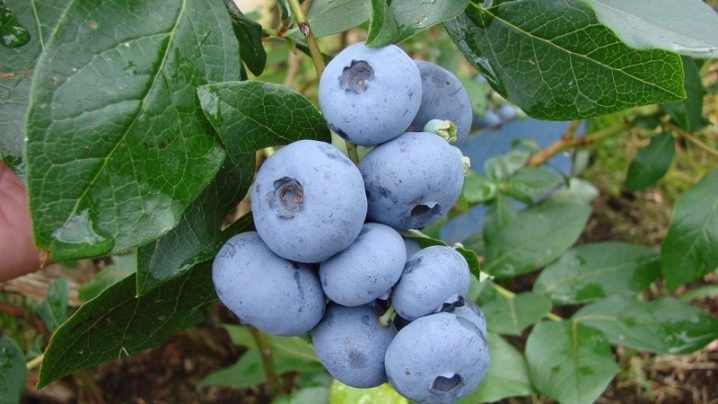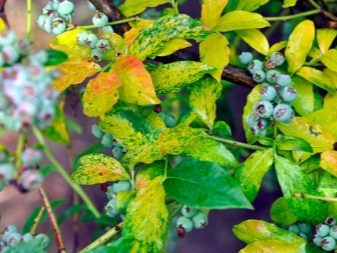Garden blueberries and their cultivation

Garden blueberries are actively cultivated in the middle lane and in the south of Russia. Despite the fact that the culture is quite capricious and requires careful maintenance, its high yield justifies all the efforts expended.

Peculiarities
Garden blueberry is a deciduous plant belonging to the Heather family. Its description indicates that the size of an adult bush is up to 2 meters or more in height. A powerful and branched bush is covered with smooth dark green leaf blades, the length of which reaches 8 centimeters. The diameter of adult branches is 3 to 4 centimeters. Blueberries have a branched root system devoid of root hairs.
The culture blooms from May to June, forming small inflorescences at the ends of the shoots that look like brushes. The fruits are rounded berries, the diameter of which reaches 2.5 cm. They are characterized by a dark blue or purple color, as well as a bluish bloom. Juicy pulp with small seeds is hidden under a thin skin.
In nature, blueberries grow in swamps, in the mountains and even on poor soils, but in the garden they prefer well-lit areas with a certain level of acidity.


The best varieties
- For the regions of the middle zone and the Moscow region, one of the best varieties is considered "Patriot". This variety is characterized by high frost resistance and good immunity. The branchy bush reaches a height of 1.2-1.8 m. Fruiting of the "Patriot" begins in mid-July. Large berries of a light blue hue reach a mass of 1.7-1.9 g. From each bush, the gardener receives 4.5-7 kilograms of fruit.

- The Duke variety is no less popular. After a quick ripening, bushes with a wide crown are covered with sweet berries weighing 2.5 grams. The height of the bush ranges from 1.2 to 1.8 meters. The variety ripens early, allowing harvesting in the first weeks of July. 6-8 kilograms of blueberries appear on each bush.

- "Spartan" is suitable for the southern regionsforming a tall shrub with few shoots. In mid-July, slightly sour blue fruits with a pronounced waxy bloom ripen. The gardener manages to get 6 kilograms of fruit from each bush.

- Suitable for southern regions and "Bonus", large berries of which are collected in tight clusters. On a bush with a height of 1.4-1.6 m, 4-8 kilograms of fruits appear.
The variety is medium late, and therefore blueberries with an unusual blueberry flavor ripen only by the beginning of August.

Landing
Planting of blueberry seedlings is carried out throughout the season, but in the fall it is preferable to use specimens with an open root system. In spring time, it is necessary to act when the temperature reaches +5 degrees, but in time before the formation and blooming of buds. As a planting material, it is recommended to use seedlings 2-3 years old with a developed one-year shoot. The specimens selected must be healthy and free of any cracks, stains or damaged parts. For garden blueberries, you will need to find a well-lit place, fenced off from cold winds. Ideally, this should be near a fence or structure, but away from trees or awnings.
Since blueberries react poorly to organic matter, there should be no crops around that need it. Beets, tomatoes, cabbage, apple trees and pears will become bad neighbors for the berry. The predecessors of garden blueberries can only be siderates and perennials that do not "consume" organic mixtures. The optimum acidity level should not go beyond 3.5-4.8 pH. It is better to prepare the soil for the culture yourself from peat, garden soil and a small amount of sand.
Blueberry planting holes are 40-60 centimeters deep and 60 to 100 centimeters in diameter. Between the individual pits, a gap is maintained from 60 centimeters to 1.2 meters, depending on the height of the variety. At the bottom of the hole, a drainage layer and 40-60 grams of sulfur must be laid out. A small hill is formed right in the hole, on which the seedling is installed. Having straightened the roots, it is necessary to fill the hole with soil, tamp the surface, water the garden bed and mulch.


Care
Caring for garden blueberries involves a number of common procedures, but the crop also requires pollination. It occurs with the help of bumblebees, which are able to "work" even in cool weather. Since blueberries need a pollinator, they will have to be attracted or even populated by families at the beginning of flowering. For example, in spring or early summer, you can put houses on the site facing south.
- Watering. The culture loves frequent watering, but waterlogging still negatively affects its condition. After planting, it is recommended to irrigate it every 2-3 days. If the days are dry, then the frequency of the procedure increases up to 3 times a week. For adult plants, regardless of weather conditions, watering at a rate of 10 liters for each instance once every 2 weeks will be enough. A plus will be the placement of a drip irrigation system on the garden bed, as well as periodic acidification of the soil. For the last time in 2 weeks, you will need to dilute a teaspoon of citric or oxalic acid in 3 liters of water.
- Top dressing. Blueberry feeding is carried out in several stages. For this purpose, it is recommended to use a ready-made mineral complex - for example, "Target" or "Florovit". For the first time, fertilizers are applied in mid-April, the second in mid-May. The final feeding is organized a month later. Even if the schedule goes wrong, we must not forget that the application of nitrogen-containing fertilizers should be stopped before July.
- Pruning. Since bush blueberries grow rapidly, all types of pruning have to be used for it. The shaping procedure is organized in the spring, but only from the fourth year of the plant's life. Its main goal is to create the correct crown, allowing the light rays to reach all the branches of the bush. Regulatory pruning is carried out at the end of summer, also from the fourth year of the plant's life. Within its framework, blueberries are freed from old twigs, and new ones are shortened. Garden blueberries need rejuvenation every 8-10 years. This procedure requires almost complete pruning of the bush with the exception of 5-6 young branches.
- Wintering. Blueberries are able to withstand cold snaps down to -25 degrees and even recover from frostbite, but it is still more correct to provide them with protection before wintering. Before the onset of frost, the plant is water-charged, after which its branches are neatly tied and bent to the ground. The bed is mulched with bark and pine thorns, and the whole bush is covered with spruce branches or similar material.


Reproduction methods
There are 4 main ways to breed garden blueberries. The seed is usually chosen by breeders. The procedure is laborious and time-consuming, and the resulting plants do not inherit varietal traits. The seed is extracted from the ripe berries. After drying, it is either stored in paper bags, or immediately planted for germination.The germination of the grains lasts for 12 years, but before planting in this case, they need to be kept in moist sand at a temperature of + 3-5 degrees for 3 months. The prepared material is distributed in containers filled with moistened peat. The containers, in turn, are placed in a well-heated and well-lit place. When 5 full-fledged leaves appear on the seedlings, they are transferred to the greenhouse. After wintering under spandbond the next spring, the plant moves to a "training" garden or pots.
In early spring or autumn, blueberries are propagated by dividing the bush. It is possible to use and cuttings using lignified and semi-lignified workpieces with a length of 10 to 15 centimeters. Lignified twigs are cut from December to March, and semi-lignified branches - from late June to the second half of July. Cuttings should be rooted in the greenhouse after treatment with a preparation that stimulates the development of roots.
Finally, it is suitable for garden blueberries and the layering method. For this, the lateral shoot is bent to the ground, fixed with staples and sprinkled with soil with sawdust. After a couple of seasons, roots will appear at the layer and it can be separated from the mother bush. The growing of the resulting blueberries is carried out in a nursery or container.


Diseases and pests
Garden blueberries are often exposed to viral infections: mosaic, dwarfism or red ring spot. In addition, the plant is characterized by gray rot and white spotting, stem cancer and phomopsis. Treatment of all of the above diseases is carried out with fungicides and Bordeaux liquid. However, in the case of dwarfism, mosaic and filamentousness, the plant usually has to be destroyed. To cope with fungi, before and after flowering, it will be necessary to spray the bush three times with a 0.2% solution of Euparen or Topsin. The damaged parts must be cut off beforehand and burned.
From insects, blueberries attract the caterpillar of the pine silkworm, aphids, the May beetle, the leafworm and the tick. They do the main harm to the plant by eating leaves and buds, as well as absorbing sap. Purchased insecticides allow you to effectively deal with pests, and caterpillars can be easily collected by hand. To protect the crop from birds, the bushes are covered with fine mesh nets.
In addition, there are shiny objects on the branches, and sound cannons are installed nearby.


Fruiting and harvesting
Garden blueberries begin to ripen from mid-summer. First, in the second half of July, the fruits of early varieties are harvested, and then from the end of the month to the beginning of August, medium-late varieties ripen. The growing season of late varieties lasts until mid-September, but the berries can be picked from the second half of August. It is worth mentioning that in blueberries there are both "amicable" gatherings, lasting about 2 weeks, and "extended" ones - up to 5-7 weeks. When exactly to pick blueberries is determined depending not only on the characteristics of the variety, but also on the purpose for which the fruits are removed. Berries for further transportation or conservation are removed at an early stage of ripening, and directly for consumption - much later, when the pulp is filled with juice.
In general, the yield of blueberries is considered to be quite high. For example, 400-500 kilograms of berries are ripening per 1 hectare of "Northland" variety plantations per season. At the same time, from one bush, you can collect from 5 to 8 kilograms of fruit. The Bluerop variety demonstrates even more outstanding results: 7 kilograms per bush, 600 kilograms per hectare. On average, from one bush of garden blueberries, you can get at least 3 kilograms, and from 1 hectare - 250 kilograms. It is also necessary to clarify that blueberries begin to bloom 3 years after planting, then the first berries appear, but the culture fully bears fruit only from 6 years old.
The fruits of garden blueberries can survive for a considerable time on the bush, so there is no need to rush to remove them. It is recommended to carry out the procedure once a week, removing softer and sugary berries and leaving strong and firm berries on the branches. Fresh blueberries can be stored in the refrigerator for about 4 weeks, and at room temperature for 1-1.5 weeks. Finally, it should only be transported in wooden crates.

Application in landscape design
The composition, the center of which will be blueberries, will be an adornment of any suburban area. So, the plant will harmoniously combine with lingonberries, cranberries, conifers, dwarf azaleas and hydrangeas. At the dacha, berry bushes can be planted around the perimeter of the recreation area, thereby zoning with a hedge.
It is recommended to select for this purpose the varieties "Bluegold", "Berkeley", "Herbert" or "Northland", which have a dense spherical shape. In the background of landscape compositions, tall blueberries of the Chandler or Eliot varieties look perfect. Plants in boxes made of solid wood, brick or stones will look interesting on the veranda or in the gazebo.








The comment was sent successfully.